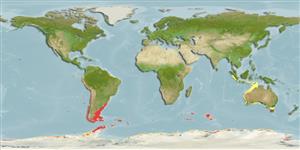Common names from other countries
Classification / Names / Names
Common names | Synonyms | Catalog of Fishes (gen., sp.) | ITIS | CoL | WoRMS
Environment: milieu / climate zone / depth range / distribution range
Ecology
Benthic; depth range 2 - 240 m (Ref. 87801). Subtropical
Indo-Pacific, Southwest Atlantic and Antarctic.
Length at first maturity / Size / Weight / Age
Maturity: Lm ? range ? - ? cm
Maximum depth from Ref. 92901. This species is found on hard substrates like mollusc shells at depths of 2 to 25 m (Ref. 87801).
Life cycle and mating behavior
Maturity | Reproduction | Spawning | Eggs | Fecundity | Larvae
Members of the order Leptothecata include L-form hydroids. Life cycle: The zygote develops into planula and later into polyp then into free-swimming medusa.
Bouillon, J., C. Gravili, F. Pagès, J.-M. Gili and F. Boero. 2006. (Ref. 8278)
IUCN Red List Status (Ref. 130435)
CITES status (Ref. 108899)
Not Evaluated
Not Evaluated
Human uses
| FishSource |
Tools
More information
Age/Size
Growth
Length-weight
Length-length
Morphology
Larvae
Abundance
Internet sources
Estimates based on models
Preferred temperature
(Ref.
115969): 4.5 - 13.9, mean 7.5 (based on 361 cells).
